Music is the universal language
“Glory to God in the highest heaven, and on earth peace to those on whom his favor rests.” - Luke 2:14
General Interest
New Source Audio Delay + Reverb Pedal
EHX Intros Pico Swello Attack Envelope Pedal
Gibson Custom Introduces Five New Murphy Lab Light Aged Acoustics
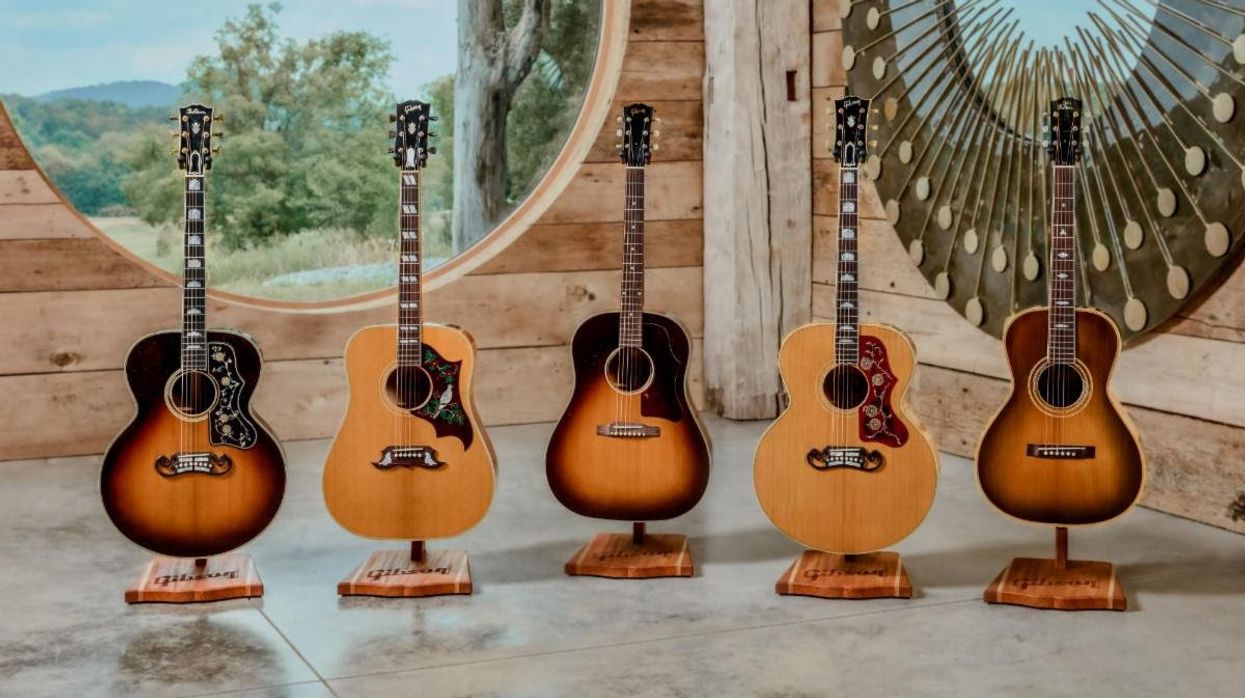
Gibson is proud to introduce five new acoustic reissues for the Gibson Custom Murphy Lab Light Aged acoustic collection, delivering well-worn favorites, built brand new, with the look, tone, and played-in feel of cherished vintage originals.
Each one of the five new additions to the Gibson Custom Murphy Lab Light Aged acoustic collection is a masterfully crafted reproduction of a cherished Gibson acoustic guitar model from Gibson’s first Golden Era. The Murphy Lab Light Aged acoustic lineup from Gibson Custom all feature either red spruce or Sitka spruce tops that have been thermally aged to give them the sound of a well-seasoned vintage guitar. The new additions to our Murphy Lab Light Aged lineup of vintage acoustic reissue models feature light lacquer checking, light dings, pick trails, and rounded fretboard edges, giving them the tone, look, and played-in feel of cherished vintage originals. Gibson Custom Murphy Lab Light Aged acoustic guitars are well-worn favorites, built brand new.
Explore the full Gibson Custom Murphy Lab Light Aged acoustic collection, now available worldwide on Gibson.com HERE.
Each acoustic guitar in the Murphy Lab Light Aged collection comes with an era-correct hardshell guitar case that corresponds with the style of case that was in use when that model was released, adding to the vintage ownership experience.
1929 Nick Lucas Special Light Aged
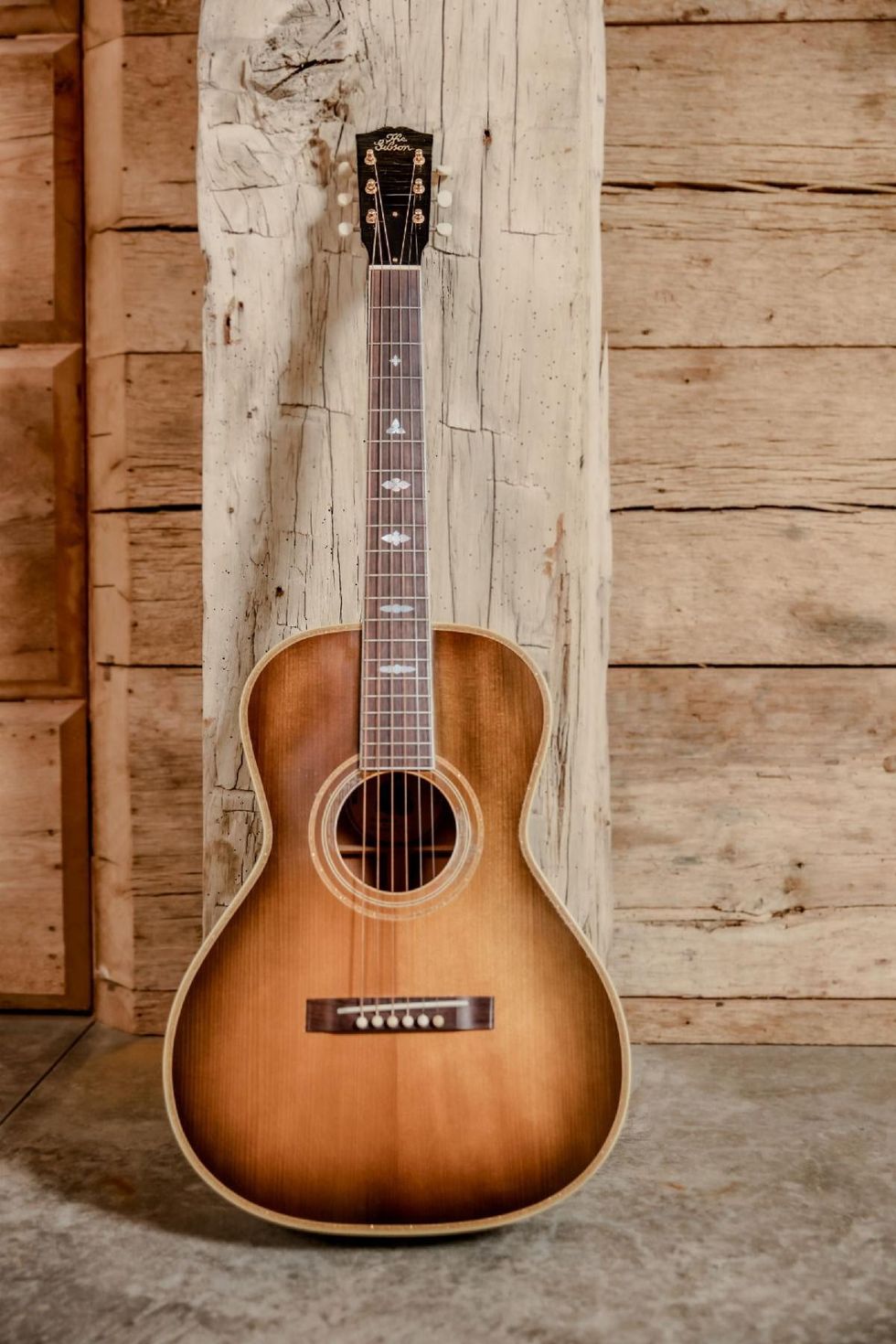
A small-bodied legend with a big voice
Nick Lucas, known as “The Crooning Troubadour,” was a pioneering entertainer of the 1920s—one of the first to record guitar solos and perform with a guitar on the radio. His influence helped elevate the guitar as both a solo and accompaniment instrument. In 1926, Gibson honored Lucas’s request for a custom design, resulting in the Nick Lucas Special—the company’s first artist signature model, featuring a deeper body for enhanced bass response and tonal richness.
Now, Gibson Custom proudly introduces the 1929 Nick Lucas Special Light Aged, a stunning recreation of this historic model. Built with a deeper mahogany body shaped like the L-00, it features a thermally aged red spruce top, gold sparkle multi-ply binding, and a matching L-2 style rosette. The mahogany neck joins the body at the 12th fret and has a C-shaped profile. The bound rosewood fretboard is equipped with 20 frets and is adorned with mother-of-pearl Nick Lucas inlays with engraved details. Gold Waverly tuners with ivoroid oval buttons are installed on the headstock, which also features a vintage-style “The Gibson” logo in mother-of-pearl. Finished in Argentine Grey with Murphy Lab Light Aging, it captures the look and feel of a well-loved original. Housed in a Red Line-style case, this model delivers timeless tone and unmatched character.
1963 Dove Light Aged:
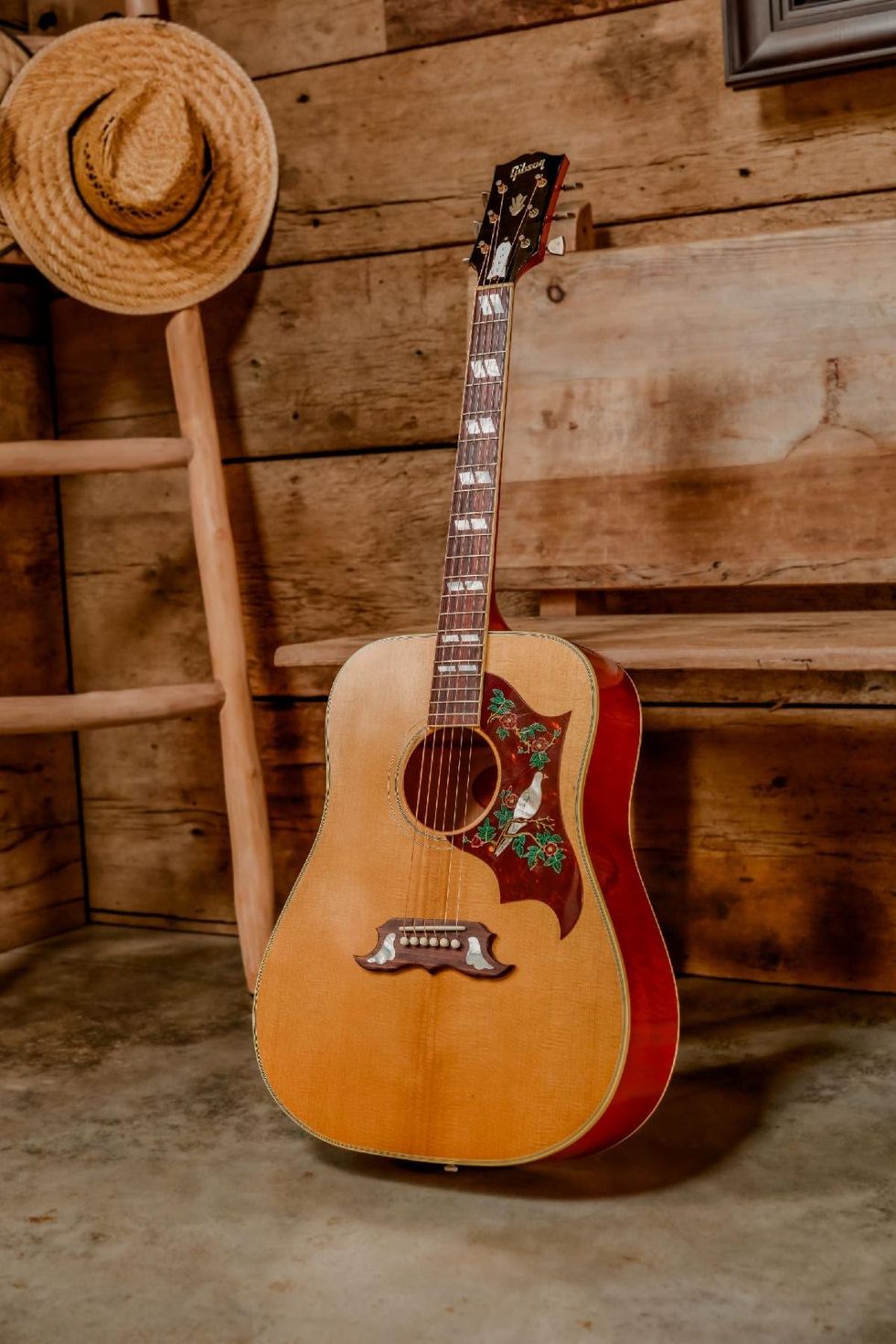
All the tone, charm, and character of a vintage Dove—reborn
First introduced in 1962, the Gibson Dove™ quickly became an icon of the square-shoulder acoustic family, following the Hummingbird™. With its bold voice and distinctive look, the Dove has been favored by legends like Elvis, Tom Petty, and Alex Lifeson. Now, Gibson Custom proudly presents the 1963 Dove Light Aged—a meticulous recreation of the early Dove models, crafted to deliver vintage tone and feel in a brand-new instrument.
Featuring a thermally aged Sitka spruce top with traditional scalloped X-bracing and beautifully flamed maple back and sides in a Cherry finish, this Dove sings with clarity and power. The mahogany neck has a comfortable Round profile, paired with an Indian rosewood fretboard adorned with mother-of-pearl parallelogram inlays. A longer 25.5” scale length and maple body give it a bright, full voice that stands apart from the Hummingbird.
Details like the rosewood Dove bridge with inlaid doves, engraved pickguard, and Kluson® Waffleback tuners complete the vintage aesthetic. Lightly aged by the Murphy Lab, it offers the look and feel of a well-loved original and comes housed in a vintage-style black hardshell case for the full Gibson Custom experience.
1955 J-45 Light Aged:
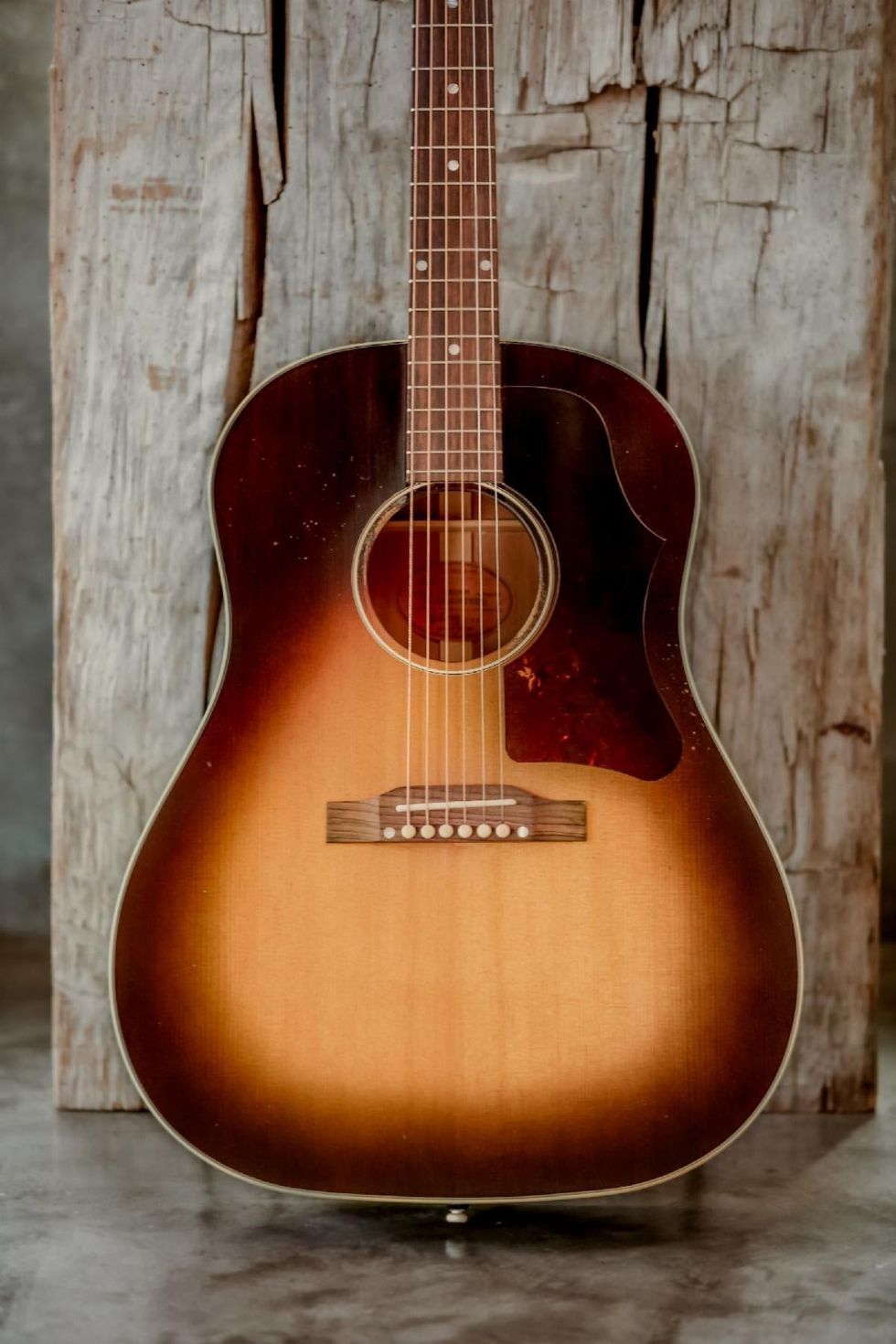
A faithful tribute to the mid-50s Workhorse
First introduced in 1942, the Gibson J-45™ quickly earned its nickname, “The Workhorse,” for its straightforward design, warm tone, and unmatched versatility. By 1955, key updates—like a longer fretboard with 20 frets and a larger pickguard—helped define the model’s enduring legacy. Today, it remains one of the most recorded and best-selling acoustic guitars of all time.
The 1955 J-45 Light Aged from Gibson Custom is a masterfully handcrafted recreation of this pivotal model, built in Bozeman, Montana. It features a round-shoulder mahogany body with a thermally aged Sitka spruce top and traditional X-bracing installed with hide glue for vintage tone and resonance. The mahogany neck has a comfortable Round profile and is joined with a compound dovetail neck joint. A rosewood fretboard with mother-of-pearl dot inlays, bone nut and saddle, and vintage-style Grover® strap tuners complete the classic look.
Finished with Murphy Lab’s Light Aging treatment and lightly aged hardware, it captures the feel of a well-played original. Packaged in a 1950s-style Lifton™ hardshell case, the 1955 J-45 Light Aged delivers the authentic tone, vibe, and craftsmanship of Gibson’s Golden Era.
Pre-War SJ-200 Rosewood Light Aged:
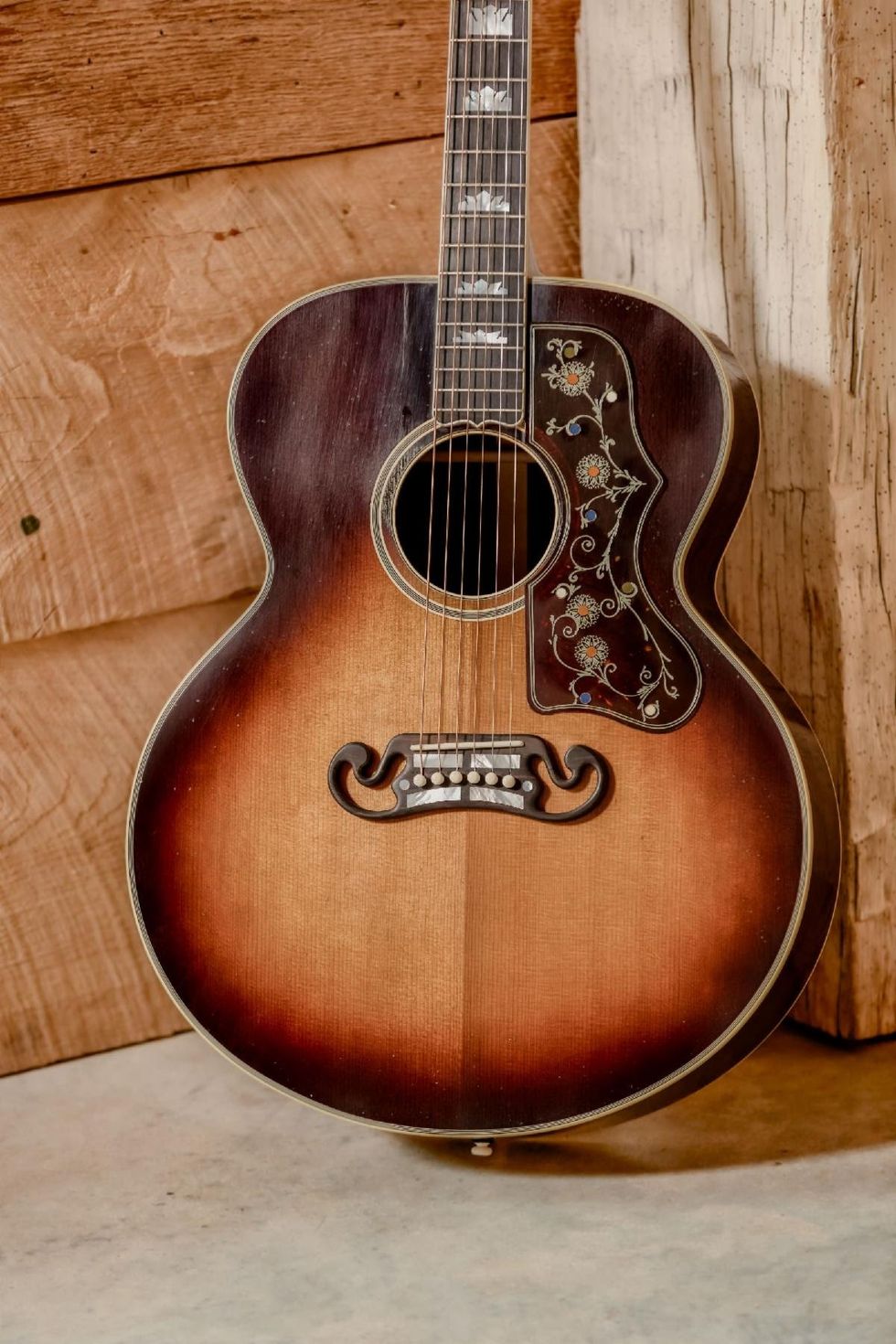
All the vibe, feel, and vintage allure of the rare rosewood Pre-War Super Jumbo
Originally introduced in 1937, the Gibson SJ-200™ quickly earned its title as “the King of the Flat-Tops” thanks to its bold sound, impressive projection, and commanding presence. Early models featured rosewood back and sides, but due to limited demand during the post-Depression era, production numbers remained low—making these early rosewood-bodied SJ-200s highly sought-after by collectors today. Gibson Custom now proudly presents the Pre-War SJ-200 Rosewood Light Aged, a meticulous recreation of those rare originals. It features a thermally aged red spruce top with traditional scalloped X-bracing, rosewood back and sides with a three-rope marquetry strip, and ornate multi-ply binding throughout. The AAA maple neck includes a walnut stringer and stinger detail, while the ebony fretboard and bridge are adorned with mother-of-pearl inlays. Gold Grover® Imperial™ tuners and a tortoise pickguard with multi-colored dots complete the look.
Finished with Murphy Lab’s Light Aging treatment and housed in a period-correct Red Line case, this model captures the spirit and craftsmanship of Gibson’s Golden Era—delivering vintage tone, feel, and aesthetic in a stunning modern build.
1957 SJ-200 Light Aged:
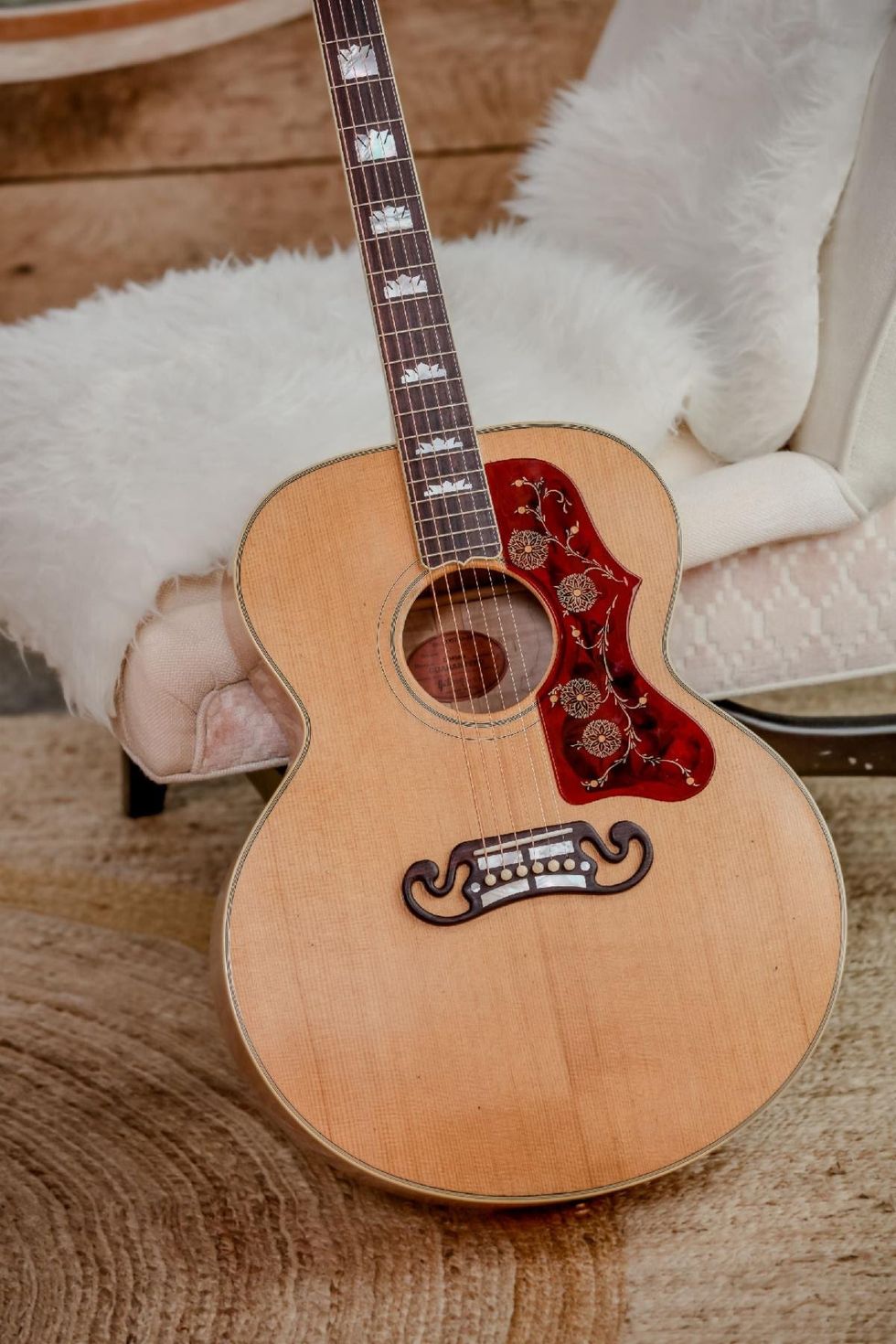
All the vibe, feel, and vintage allure of the iconic 1950s Super Jumbo
Introduced in 1937, the Gibson SJ-200 earned its reputation as “the King of the Flat-Tops” for its bold tone, powerful projection, and striking presence. By 1947, maple replaced rosewood for the back and sides, and the SJ-200 became a favorite among legends across genres—from Hollywood cowboys to rock royalty. Today, vintage 1950s models are prized by collectors.
Gibson Custom now presents the 1957 SJ-200 Light Aged, a faithful recreation of this celebrated era. It features a thermally aged Sitka spruce top with scalloped X-bracing installed using hide glue, AAA flamed maple back and sides with a checkerboard marquetry strip, and ornate multi-ply binding. The AAA maple neck includes a walnut stringer and stinger detail, while the rosewood fretboard and Moustache™ bridge are adorned with mother-of-pearl inlays. Gold Gotoh® tuners and a classic tortoise pickguard complete the vintage aesthetic.
Finished with Murphy Lab’s Light Aging treatment and paired with lightly aged hardware, this model captures the look and feel of a well-played original. It comes housed in a period-correct 1950s-style Lifton™ case, delivering an authentic vintage experience only Gibson Custom can offer.
Alex Skolnick Trio Announces New Album 'Prove You’re Not A Robot'
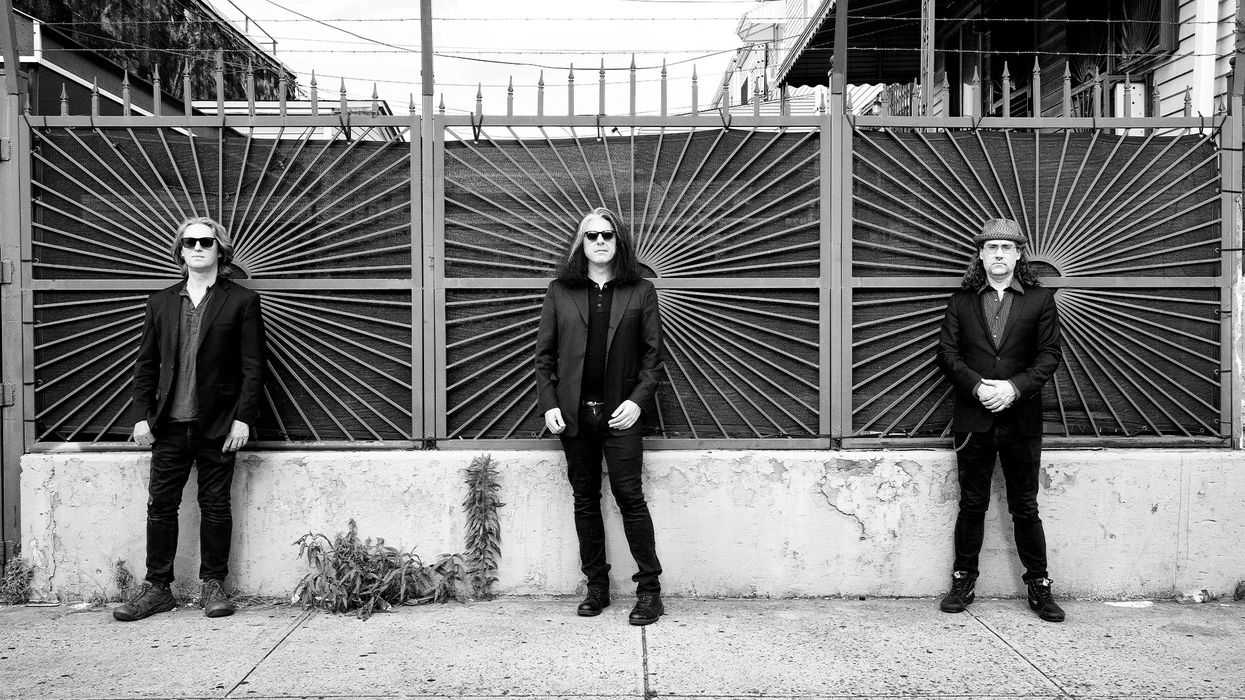
Brooklyn-based jazz-rock innovators Alex Skolnick Trio (AST) return this fall with PROVE YOU’RE NOT A ROBOT, the group’s sixth LP, arriving November 7, 2025. The album’s first single, a wildly inventive take on Tom Petty’s “Breakdown,” is available today. Listen here.
Blending fearless improvisation, genre-defying arrangements, and the virtuosity of its members, PROVE YOU’RE NOT A ROBOT captures AST at the height of their creative powers. The title reflects both a wry nod to our tech-saturated era and a deeper meditation on humanity, direct interaction, and the irreplaceable spark of live musicianship in an age of artificial intelligence.
Recorded with a range of vintage and custom instruments — from a Roger Sadowsky archtop to a 1935 Gibson L-00 acoustic — the album spans moods from the uplifting “Guiding Ethos” to the mind-bending Chick Corea/Steve Howe mashup “Armando’s Mood.” Alongside Skolnick’s inventive guitar work, bassist Nathan Peck and drummer Matt Zebroski bring rhythmic complexity and emotional depth, with odd-time signatures and genre twists that have become AST hallmarks.
“I feel this album represents my strongest work as a composer,” says Skolnick. “Nathan and Matt really brought their A-game throughout. I think it’s safe to say this is the record we’re all most proud of.”
Since forming in the early 2000s, AST has reimagined the jazz guitar trio, melding influences as far-reaching as Wes Montgomery, Black Sabbath, Prince, tango, calypso, and Western swing. Known for their adventurous covers of rock and metal classics, they’ve earned praise from outlets like Billboard, Downbeat, Jazziz, The Village Voice, and NPR, and have toured internationally, captivating audiences from Norway’s Larvik Guitar Festival to Paris’s The Olympia and New York’s Radio City Music Hall.
PROVE YOU’RE NOT A ROBOT promises to be a bold addition to the AST legacy — as engaging for jazz aficionados as it is for rock fans curious about the inventive, genre-bending journey of Testament original guitarist Alex Skolnick.
Album Release Date: November 7, 2025
First Single “Breakdown” Release Date: September 12, 2025
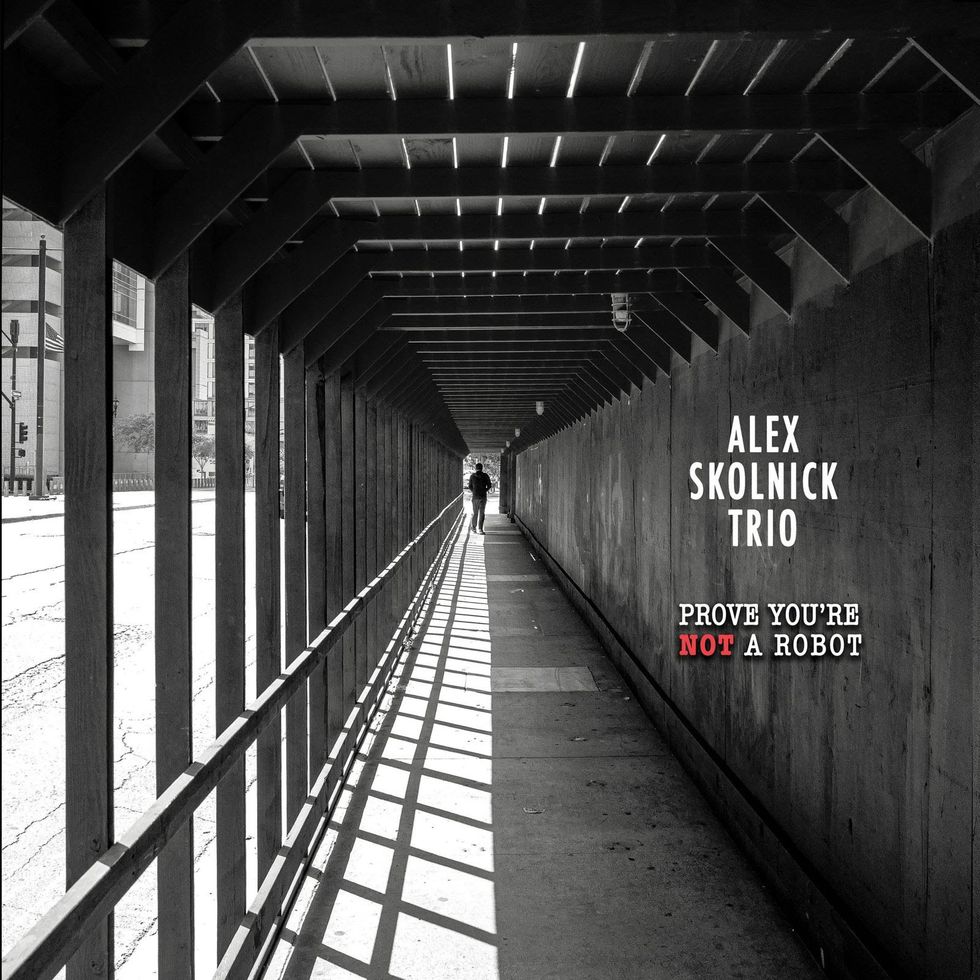
PROVE YOU’RE NOT A ROBOT Tracklist
- Parallel Universe
- Armondo’s Mood
- Infinite Hotel
- Prove You’re Not A Robot
- Guiding Ethos
- Breakdown
- The Polish Goodbye
- Asking For A Friend
AST on Tour
September 30 - New York, NY, The Cutting Room (Album launch party)
November 15 - Montreal, QB, Piranha Bar
November 16 – Ottawa, ON, Brass Monkey
November 17 – Pittsburgh, PA. City Winery
November 19 – Detroit, MI, Token Lounge
November 20 – Chicago, IL. Reggie’s
November 21 – Cleveland, OH, Irishtown Bend Tap Room
November 22 – Buffalo, NY, Nietzsche’s
November 23 – Anniville, PA, The Allen Theatre
2026
January 8 – The Woodlands, TX, Dosey Doe
January 9 – McKinney, TX, Guitar Sanctuary
January 11 – San Antonio, TX, Fitzgerald’s
January 13 – Los Angeles, CA, Baked Potato
January 14 – Sacramento, CA, Harlow’s
January 15 – Seattle, WA, Funhouse
January 16 – Portland, OR, Jack London Revue
January 17 – Redding, CA, The Dip
January 18 – Mill Valley, CA, Sweetwater Music Hall
Alex Skolnick Trio is:
Alex Skolnick – Guitar
Matt Zebroski – DrumsNathan Peck - Bass
D’Addario Launches Players Choice Custom String Shop
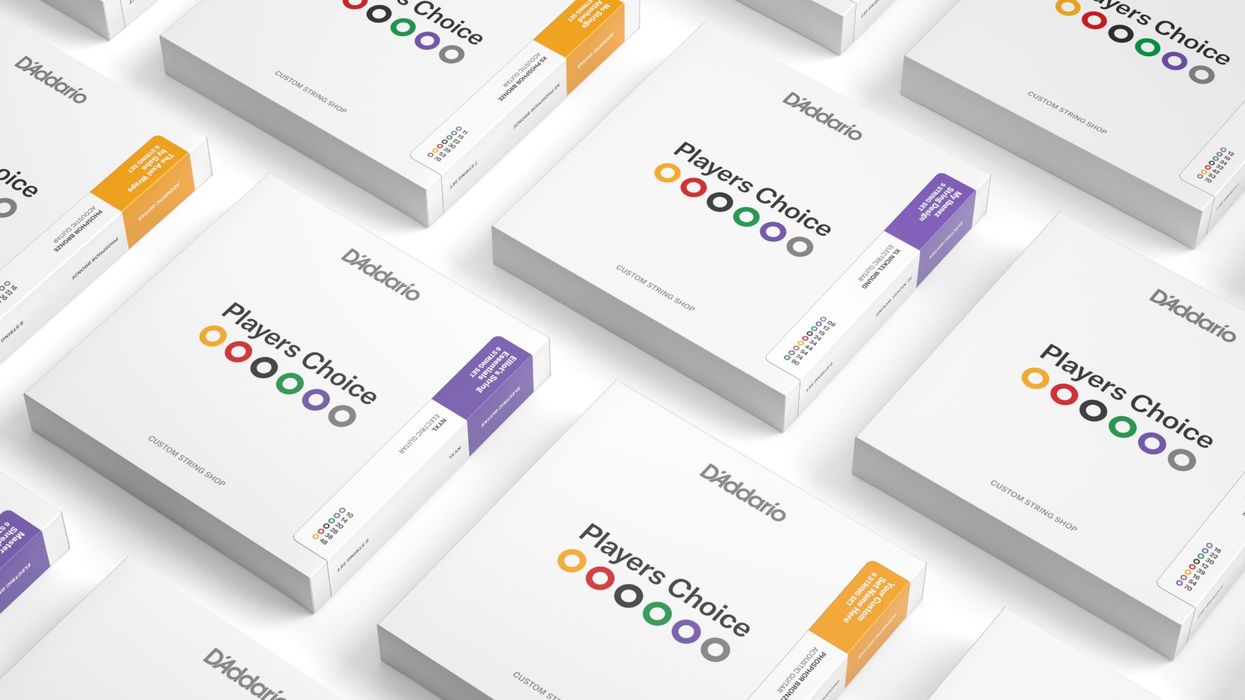
D’Addario announces the launch of the Players Choice Custom String Shop, a new online tool that lets players design their own string sets, all backed by D’Addario’s long-standing quality and craftsmanship.
Available exclusively on daddario.com, the platform allows players to select their instrument of choice and then choose from the most popular gauges and alloys across electric and acoustic guitar strings. Even better, no minimum order is required. Custom sets can be saved to a Players Circle profile for fast reorders, and every purchase you make in the Custom String Shop earns Players Circle rewards points.
From the Visionary Behind D’Addario
“Musicians looking for their ‘perfect string set’ need an intuitive way to experiment on screen and find the perfect combination of gauges and alloys to satisfy their requirements,” said legendary founder Jim D’Addario.
“We created the Players Choice Custom String Shop to satisfy everyone’s customization needs.”
Availability & Pricing

Players Choice Custom String Shop is available in the USA, Canada, and Europe, where Players Circle is available. Prices start at $10.30 for electric sets and $11.70 for acoustic sets.
Key Highlights
- Build custom sets for electric and acoustic guitars now, with support for more instruments coming in the future
- Choose from our most popular gauges and alloys, including the lightest and heaviest gauges, and even half gauges
- Design sets for standard 6- and 12-string guitars, as well as extended-range 7-, 8-, and 9-string guitars
- Choose from our most popular strings, including industry-standard XL, Chromes, and Phosphor Bronze strings. Or upgrade to premium NYXL and XS coated options
- Name your set, printed right on the label
- No minimum order quantity
- Save, reorder, and earn Players Circle rewards
Learn more! www.daddario.com/custom-strings
Guitarist Mike Scott Tells Us All the Prince Stories | 100 Guitarists Podcast
Hit-making guitarist Mike Scott—who’s worked with everyone from Justin Timberlake to Janet Jackson—showed up in Minneapolis from his hometown of D.C. and started snatching everyone’s gigs. Soon, he ended up at Paisley Park, jamming with the man himself and joining his band, New Power Generation.
This masterful storyteller joins 100 Guitarists to talk all things Prince, cracking us up along the way with firsthand recollections of playing onstage and in the studio, the only time he played the “Purple Rain” solo live, and some insight on Prince and his gear.
Thanks to our sponsor EMG

LEARN MORE! emgpickups.com
Guitarist Mike Scott Tells Us All the Prince Stories | 100 Guitarists Podcast
Hit-making guitarist Mike Scott—who’s worked with everyone from Justin Timberlake to Janet Jackson—showed up in Minneapolis from his hometown of D.C. and started snatching everyone’s gigs. Soon, he ended up at Paisley Park, jamming with the man himself and joining his band, New Power Generation.
This masterful storyteller joins 100 Guitarists to talk all things Prince, cracking us up along the way with firsthand recollections of playing onstage and in the studio, the only time he played the “Purple Rain” solo live, and some insight on Prince and his gear.
Thanks to our sponsor EMG

LEARN MORE! emgpickups.com
Electro-Harmonix Releases the Pico Swello Attack Envelope
Electro-Harmonix is excited to introduce the Pico Swello Attack Envelope pedal. Inspired by the legendary POG2 ATTACK slider, the core effect of the Swello is a polyphonic attack filter which applies individual volume swells to each note you played, even within chords and through sustained arpeggios. This unique effect is paired with an adjustable Low Pass Filter for smooth swells and envelope filter-style effects.
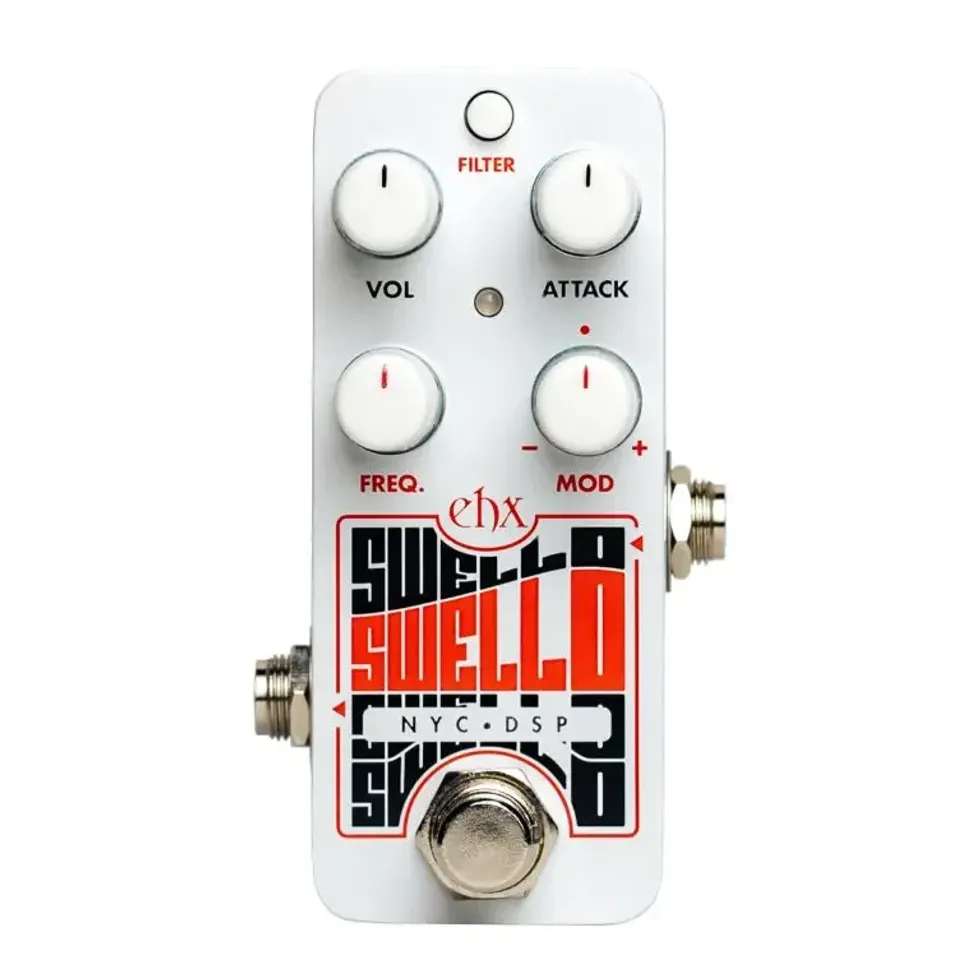
Housed in EHX’s Pico-sized chassis, the Swello has a simple four knob/one button layout. VOL adjusts the overall output of the pedal while ATTACK sets the attack envelope time. Low ATTACK settings attenuate just the initial attack of your instrument, while higher settings offer epic, long note swells. The Low Pass Filter is controlled by the FILTER button as well as the FREQ and MOD knobs. FILTER engages the LPF and applies an adjustable high or low resonance setting. The FREQ knob sets the cutoff frequency of the LPF and the MOD knob controls the depth and direction of the filter modulation akin to an envelope filter. Turn MOD up from noon for an upward filter sweep or down from noon for a downward filter sweep.
The EHX Pico Swello comes equipped with a standard EHX 9 Volt power supply. It will be available Mid-September and features a U.S. Street Price of $149.50.
New Michael Schenker Group Album "Don’t Sell Your Soul," Out Oct. 3
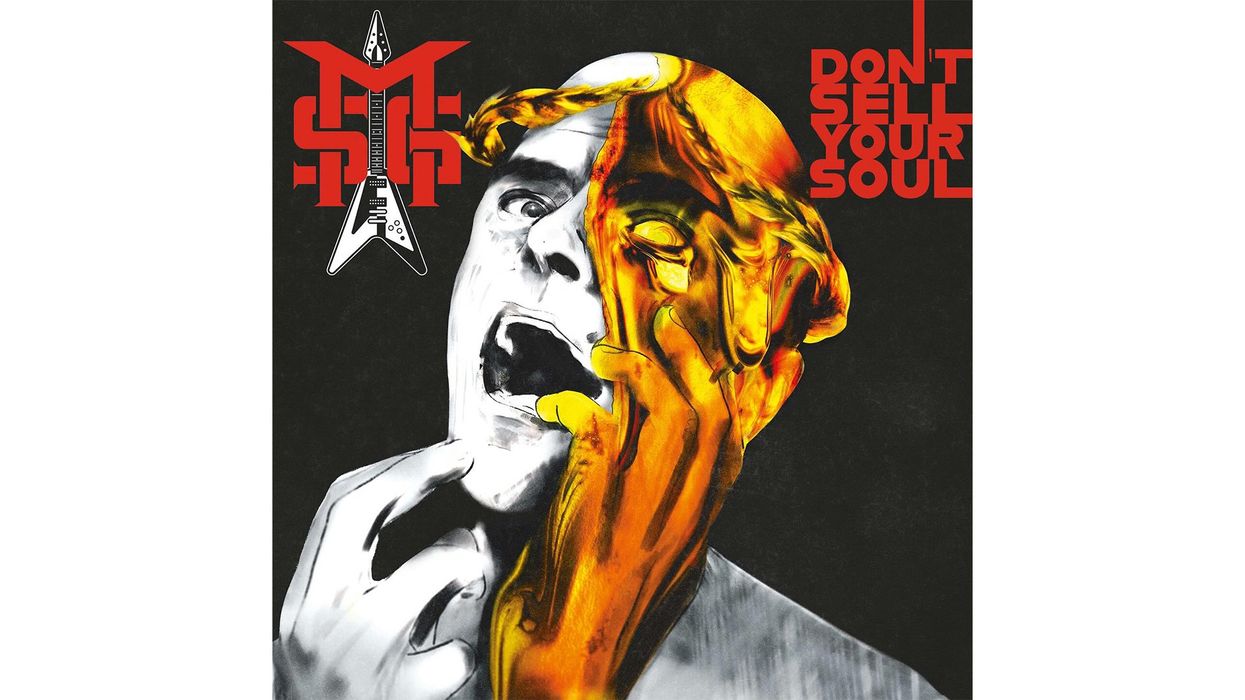
What was already a standout moment of this year's Wacken Open Air, the world's largest metal festival, turned into something even bigger when legendary guitarist Michael Schenker pulled a surprise no one saw coming. The architect of hard rock used the world's loudest stage to announce that a brand new Michael Schenker Group studio album, titled Don't Sell Your Soul, will be released on October 3 via earMUSIC.
To mark the occasion, Schenker and his band closed the show with a world-exclusive live premiere of the new album's title track — a powerful encore that took the Wacken crowd by surprise and was met with instant enthusiasm on the muddy festival fields. You can now listen to the new track HERE.
- Don't Sell Your Soul is the second part of an album trilogy that began with 2024's My Years With UFO. This will be the first studio album for MSG since Universal in 2022.
- The album was produced by Michael Schenker and Michael Voss, and recorded with Schenker's longtime allies: Bodo Schopf (drums), Barend Courbois (bass), and Steve Mann (guitar, keys). On vocals: the impeccable Erik Grönwall (Skid Row, H.E.A.T) – undoubtedly one of the finest rock voices of his generation. Guest appearances on vocals by Robin McAuley, Dimitri "Lia" Liapakis, and Michael Voss round out the cast.
- The Michael Schenker Group was formed in 1979 and has released 12 studio albums with many different members over the years, with Schenker the only constant presence.
- Michael Schenker played in the rock band UFO and leads the Michael Schenker Group (MSG). He was an early member of the hard rock band Scorpions, a band co-founded by his elder brother Rudolf Schenker.
- Michael Schenker is regarded as one of the most influential guitarists of the 1970s, and is widely known as a legendary figure in the history of metal guitar.
Michael Schenker is an undisputed living legend and it is time to sell your soul with MSG. Let us know what you think! Michael IS doing a limited amount of interviews so let's talk and see what we can set up!
Nigel Tufnel uses BIG EAR Pedals’ Slice Of Pie fuzz in Spinal Tap II – can you work out the other pedals across his three ‘boards?

Of course Spinal Tap’s Nigel Tufnel has a massive pedal set up – what else would you expect from a rockstar whose amp can be cranked all the way to infinity?
Nestled in one of his three pedalboards spotted in the sequel to the legendary mockumentary, Spinal Tap II: The End Continues, Tufnel is found to be using the Slice Of Pie pedal from boutique brand BIG EAR – one of just two pedals that were specifically written into the script, according to BIG EAR itself.
- READ MORE: The Tone Mob Podcast’s Blake Wyland on the Slice Of Pie pedal and the guitar he’d save in a fire
Shaped like a slice of pizza and made in collaboration with The Tone Mob Podcast, this fuzz pedal’s quirky design is very apt for the over-the-top – and sadly fictional – band. It’s a good job it’s not shaped like tiny bread, however, or there would be a problem.
Writing on Instagram, BIG EAR shares its joy at having its pedal featured within the film, and also handily identifies a vast number of other pedals across the boards. Some do remain a mystery though, with film only just having landed in cinemas and imagery of still scarce.
“Got the first visuals from the new Spinal Tap movie.. They’re not the best quality, but that’s a Slice Of Pie right up front! I haven’t seen the film yet myself, but apparently our pedal was one of two pedals that were specifically written into the script!” says BIG EAR.
“The second slide here shows Nigel’s full rig, which is MASSIVE and has many unidentified pedals! Can you help me identify any of these?! The third slide has a list of the pedals we’ve been able to identify so far.. but there are still 13 pedals to figure out! Heelllpppp!!”
With a little help from Eric Merrow and 1981inventions, BIG EAR has spotted the following on Tufnel’s main board, working from left to right:
Bottom row
- RJM – Mastermind PBC/10
- Danelectro – Back Talk (Reissue)
- BIG EAR pedals x The Tone Mob – Slice Of Pie (Cheese version)
- Littletone – CLYDE Wah
Middle row
- Strymon – Cloudburst
- TC Electronic – CHOKA
- Strymon – Timeline
- T-Rex – Replica
Top row
- Strymon – Zuma (Power Supply)
- Strymon – Ojai (Power Supply, on top of Zuma)
- TC Electronic – Polytune Mini
- Vahlbruch Effects – Kaluna II HV Tube Drive
- BOSS – BD2 Blues Driver
- BOSS – CS-3
- KORG – Miku Stomp (On what appears to be a Junction Box)
And there are many more, especially across his other two boards… Check out the full list in the Instagram post below, and see if you can fill in the blanks:
Spinal Tap II is in cinemas now. You can also check out more from BIG EAR Pedals.
The post Nigel Tufnel uses BIG EAR Pedals’ Slice Of Pie fuzz in Spinal Tap II – can you work out the other pedals across his three ‘boards? appeared first on Guitar.com | All Things Guitar.
David Gilmour is open to a Pink Floyd avatar show at the Las Vegas Sphere: “I’m hoping to go there and watch myself… So I don’t actually have to get up and do it”

David Gilmour is hoping to watch a Pink Floyd avatar show at the Las Vegas Sphere one day, and apparently, it’s something he’s always wanted to do.
With the Sphere already having hosted acts such as Dead & Company, the Eagles, and U2, Floyd could make for a great band to take to the stage next, allowing for its core lineup to reunite for the first time since 2005 in digital form.
During a Q&A at the UK premiere of his Live At The Circus Maximus concert film at London’s BFI IMAX, Gilmour was asked about the Sphere: “I’m hoping one of these days to go there and sit and watch myself doing it, which is something I’ve always wanted to do. My avatar, you know? So I don’t actually have to get up and do it,” he replies (via MusicRadar).
Gilmour also shared interest in the Sphere in an interview with Rolling Stone earlier this September, in which he said, “In the future, who knows. I haven’t got that far. It will be in there amongst the plans that we are to think about.”
The Las Vegas sphere cost over $2 billion to construct, and hosts the world’s largest LED screen. Take a look at one of U2’s performances from inside the venue below:
If Pink Floyd were to be immortalised as avatars, they’d be joining the likes of Kiss – who announced a virtual, eternal era for the band following their final ever show at Madison Square Garden – and ABBA, whose Voyage concerts popularised the format.
Earlier this year, Paul Stanley spoke of the band’s retirement and their next, virtual steps: “Do I miss being on stage in front of 50,000 people, 100,000 people? Hell, yeah… Everybody who’s attained that kind of success, sure, you miss it, but there’s a difference between missing and yearning,” he told S.E Cupp on her podcast.
“We sold Kiss, which is something that’s unheard of, that doesn’t even exist in the lexicon of music. We sold Kiss [several] months ago – I mean, everything: the logo, the makeup, the music. And there’ll be an incredible, immersive musical experience that’ll debut in ‘27 that George Lucas [filmmaker] is involved in… That lives forever, but I can’t.”
Find out more about the Las Vegas Sphere, or view the full list of cinema screenings for the Live At The Circus Maximus concert film via David Gilmour’s official website.
The post David Gilmour is open to a Pink Floyd avatar show at the Las Vegas Sphere: “I’m hoping to go there and watch myself… So I don’t actually have to get up and do it” appeared first on Guitar.com | All Things Guitar.
“I don’t think I would have ever been able to live it down”: Wolfgang Van Halen on why he was worried playing his father’s songs could have “ruined my life”

Carrying Eddie Van Halen’s last name comes with a weight few could imagine. For Wolfgang Van Halen, that pressure is magnified every time he’s asked to perform one of his father’s songs – a request he almost always declines.
Since Eddie’s death in 2020, Wolfgang has only broken that rule twice. The first was in 2022 at the Taylor Hawkins tribute concert, where he ripped through On Fire and Hot For Teacher alongside Dave Grohl, Justin Hawkins and Josh Freese. The second one came at the 2024 Welcome to Rockville festival, where he stunned the crowd with a searing rendition of Eruption.
But behind the bravado was a very real fear. Speaking to Metal Hammer, Wolfgang recalls how he wrestled with Grohl’s invitation to perform at the Hawkins tribute: “I was like, ‘This is either going to be a nice coda to Van Halen or it’s going to ruin my life.’”
He explains, “I don’t think I would have ever been able to live it down – with how many people who hate me and say, ‘You’ll never be good enough and you have to play Van Halen to be relevant’ – if the one time I played Van Halen on my own, I ruined it and messed up. In my mind, it would have ruined my life had I messed up. I took it very seriously.”
That anxiety helps explain why Wolfgang now keeps his distance from his father’s legacy. In a June interview with Drumeo, the Mammoth frontman revealed that he and his uncle, drummer Alex Van Halen, have a similarly cautious relationship with the band’s catalogue.
“I’m really just not interested in playing it anymore without dad,” he said. “And I know [Alex] feels the exact same way.”
“I’ll play it for fun every now and then. If Dave Grohl comes to me and goes like, ‘Hey, you wanna do this?’ Like, ‘Yes, Dave Grohl, I would like to do that with you.’ But, overall, it’s really a tough thing for me.”
The post “I don’t think I would have ever been able to live it down”: Wolfgang Van Halen on why he was worried playing his father’s songs could have “ruined my life” appeared first on Guitar.com | All Things Guitar.
“It’s ironic that 80-year-old people are still suing each other”: John Fogerty reflects on decades of lawsuits with Creedence Clearwater Revival

Creedence Clearwater Revival’s John Fogerty is no stranger to legal battles.
From fighting record label boss Saul Zaentz to courtroom clashes with his own bandmates, Fogerty’s career has been as defined by legal strife as it has by the songs that made CCR legendary. In 2023, after more than half a century of wrangling, he finally secured the US and worldwide rights to the band’s catalogue.
Now, at 80, Fogerty says he’s grown more at ease with his past. Asked what he sees when he looks at photos of his younger self, the guitarist tells CBS Sunday Morning: “Well, I’ve gotten more comfortable with that person in those pictures from long ago, and so I think that allows me to feel better about it, I suppose.”
“How can I say it? I was confused about the tension and the grumbling that was going on within the band, and certainly, we ended up having a really troubled relationship with Saul, who was the owner of the label. And because it was not a big label, it became personal, because we knew that individual person and he was screwing us.”
Fogerty adds that his later victories in the music business have allowed him to look back with some relief: “The reason I’m more comfortable is because it has turned out okay now, right? But for many years, I would look at those pictures and be sad, because it was sort of a tragic thing. I think the kid doing it at the time just thought, ‘Oh, whoa. I tried really hard, and I was hoping to grow up and be [American sports icon] Babe Ruth.’”
“I mean, who knew that it would actually come true, in a sense,” he says. “But man, it was working. I thought everybody around me could see that and understood that it was working and that this was great. And I have a feeling that they didn’t see it that way.”
Asked if he’s now “at peace with Creedence”, Fogerty admits: “Yeah, I think so. It depends on what you may mean by that. The way I accept it as inevitable – I’m laughing at myself now – I have been sued innumerable times by my former bandmates, let me put it that way. Sometimes it was actually my brother Tom, but after he passed, even his widow joined with Doug [Clifford] and Stu [Cook] and sued me.”
“It’s ironic that 80-year-old people are still suing each other,” Fogerty continues. “So if you mean at peace that way, I just accept all those things as kind of inevitable. That’s all. It’s not surprising anymore.”
On a more positive note, Fogerty recently released a new album featuring re-recorded versions of Creedence classics titled Legacy: The Creedence Clearwater Revival Years.
The post “It’s ironic that 80-year-old people are still suing each other”: John Fogerty reflects on decades of lawsuits with Creedence Clearwater Revival appeared first on Guitar.com | All Things Guitar.
“It’s a betrayal to the band who saved his life”: Nikki Sixx responds to Mick Mars’ claim that Mötley Crüe doesn’t play live
![[L-R] Nikki Sixx and Mick Mars](https://guitar.com/wp-content/uploads/2023/11/Nikki-Sixx-Mick-Mars@2000x1500.jpg)
Nikki Sixx has once again hit back at former Mötley Crüe guitarist Mick Mars’ claim that the band doesn’t actually play live.
Mars, who retired from touring in 2022 due to his battle with Ankylosing Spondylitis (AS), sued the band the following year, accusing them of cutting him off from profits and kicking him out against his will. In his lawsuit, he went so far as to allege that he was the only member performing 100 percent live during the band’s Stadium Tour and that Sixx “did not play a single note on bass”.
Speaking to the Los Angeles Times, Sixx dismisses the claims and explains that Mars’s departure was simply down to health issues.
“[Mick] came to us and said, health-wise, he couldn’t fulfill his contract, and we let him out of the deal,” the bassist recalls. “Then he sued us because he just said that he can’t tour. We were like, ‘Well, if you can’t tour, you can’t tour.’ I will probably come to that too someday.”
On the subject of backing tracks, Sixx insists the band has never faked a performance: “Anything we enhance the shows with, we actually played,” he says. “If there are background vocals with my background vocals, and we have background singers to make it sound more like the record. That does not mean we’re not singing.”
Mötley Crüe’s attorney, Sasha Frid, also writes in a statement to the LA Times: “The fact of the matter is that Mötley always plays live. Even Mars’ expert witness in the litigation, who Mars hired and who reviewed hours of footage, agreed and said that the band played live while performing. He disputed Mars’ own claims.”
Meanwhile, Sixx didn’t hide his frustration at Mars’s accusations, calling them a “crazy betrayal”.
“Saying he played in a band that didn’t play, it’s a betrayal to the band who saved his life,” he says. “People say things like, ‘Well, if you guys are really playing, then I need isolated tracks from band rehearsal.’ … It’s ludicrous.”
For now, the Crüe continue with guitarist John 5, who has handled live duties since late 2022. Their Las Vegas residency runs through October, and their latest release – a reimagined version of Home Sweet Home with Dolly Parton – recently topped the charts.
The post “It’s a betrayal to the band who saved his life”: Nikki Sixx responds to Mick Mars’ claim that Mötley Crüe doesn’t play live appeared first on Guitar.com | All Things Guitar.
Martin D-X2E Billy Strings review – “you certainly don’t need to be a bluegrass phenom to appreciate its charms”

$899/£899, martinguitar.com
Billy Strings is one of the most electrifying guitar talents on the scene right now, and so it should come as no surprise that Martin has honoured the 32-year-old bluegrass phenomenon with not one but two new signature models based on the dreadnought guitars that he loves so much.
Now the first of these guitars, launched back at NAMM in January 2025, is a near as dammit $4,000 D-28 Billy Strings is a love letter to Billy’s beloved 1940 D-28, and features such interesting appointments as a unique 25-inch scale length to give a little less tension and make bends easier, while a unique 1 23/32-inch nut width allows him to blaze up and down the fretboard – it’s a little narrower than standard.
Most of us don’t have $4,000 burning a hole in our pockets to spend on a new guitar however, and so it was a relief to see that revealed alongside the D-28 at the NAMM Show back in January was a much more affordable guitar from Martin’s Mexico-made X series.
 Image: Press
Image: Press
Martin D-X2E Billy Strings – what is it?
The X series version of Strings’ signature model is based on the D-X2E from Martin’s recently overhauled Remastered X-series. As I discovered in my review last year, that was a pretty impressive guitar in its own right, and the Strings version carries over much of the fundamentals from that.
That means you get a spruce top with Martin’s laminate HPL material on the back and sides – including the same Brazilian rosewood pattern printed on it in handsome fashion. You also don’t get any binding on this one, with a bevelled edge adding a smoother transition between the two.
It’s not just a name on the label that differentiates this from a standard D-X2E however – as some of the most important bits of the US-made version are carried over in the shape of that unique 25-inch scale length and custom nut width.
You also get a custom hemp (very apt for the ‘California sober’ Strings) embroidered gigbag with the artist’s name on it as opposed to the regular X series gigbag, and the usual Martin E1 electronics with a built-in tuner and volume, tone, and phase controls.
 Image: Press
Image: Press
Martin D-X2E Billy Strings – playability and sound
Having played the vanilla D-X2E a fair bit, the change in scale length and string spacing is instantly apparent – and it’s a very good change in my opinion. Strings is well known for his ability to blaze up and down the fretboard with otherworldly grace, and while I’m nowhere near that sort of level, I instantly find that I’m more easily able to solo and chord up and down the neck with that slightly more compact string spacing and looser string tension.
Sonically, the scale length hasn’t had too much of an impact on the overall tonality of the guitar, and it’s pretty similar to the vanilla X-series guitar in that regard. That’s no bad thing of course, as the original sounded very good, with a clear and ringing tonality. The HPL back and sides deliver more mid to high end frequencies than traditional Martin guitars, but the Spruce top helped level it out.
Compared with the Nazareth-made Strings model, you can definitely notice the bass frequencies aren’t as forward, but that’s probably to be expected when we’re comparing two guitars of such wildly different price tags.
Plugging in, and the E1 electronics are easy to use and sound good – they’re unlikely to change anyone’s life in terms of the way they reproduce your acoustic tone, but for a sub-$1,000 guitar, it’s certainly nothing worth complaining about.

Martin D-X2E Billy Strings – should I buy one?
Sticking an artist’s name on a signature model is always going to correlate with an upcharge on the ticket, and the $200 increase on this guitar over the base model shouldn’t be discounted.
But there’s an argument that what you’re getting here is a different enough ride from the vanilla D-X2E that it more than justifies that pricetag and its status as an instrument in its own right. The neck, with its unique scale length, string spacing and slimmer profile, make this feel like such a distinct instrument from any other Martin in the X series. It feels like someone has done the work and broken this thing in for you, with an easy and addictive playability that keeps you coming back for more – you certainly don’t need to be a bluegrass phenom to appreciate its charms.
Martin D-X2E Billy Strings – alternatives
I’d play them both before you pull the trigger, but if you’re not bothered by the scale length and string spacing differences on the Strings model, the vanilla D-X2E ($699) is a fine guitar for a considerable wedge less. Another fine mid-priced dreadnought made in Mexico is Taylor’s 110ce ($799) and offers the benefits of the brand’s electric-like playability and a cutaway. If you want an alternative big-bodied acoustic with more old-school charm then Epiphone’s J-45 ($799) is a very fine instrument.
The post Martin D-X2E Billy Strings review – “you certainly don’t need to be a bluegrass phenom to appreciate its charms” appeared first on Guitar.com | All Things Guitar.
Wah-Wah 101
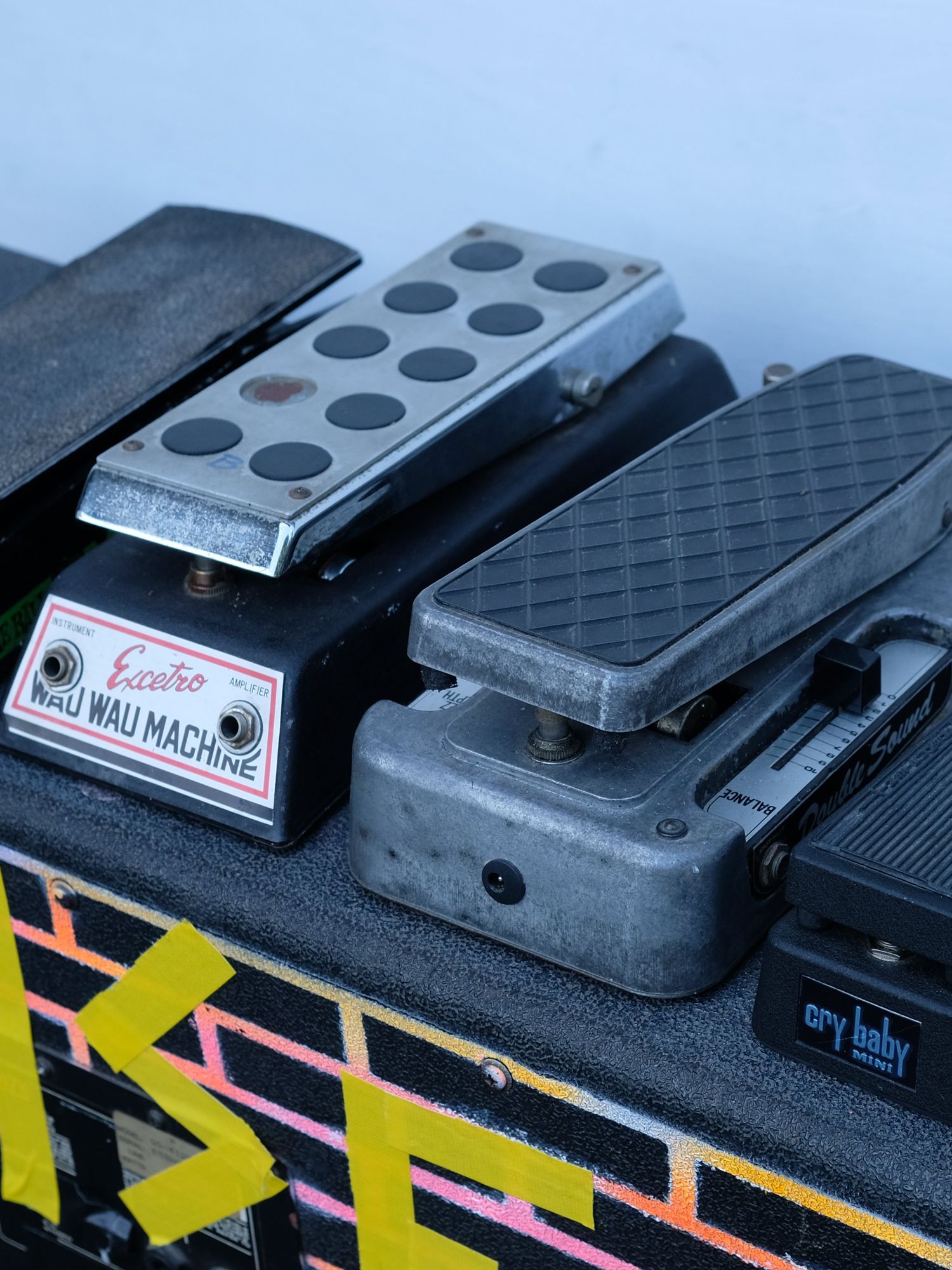
If you ask me what my favorite pedal is after fuzz, the answer is definitely wah. Bands like Fu Manchu and Dinosaur Jr. are great examples of just how powerful wah, fuzz, and a wall of amps can sound together. Sorry, I’m not into SRV voodoo or those “whacka-whacka” kinds of wah sounds.
Let’s dig a little deeper. My very first wah pedal was actually a gift from my ex-girlfriend. She told me it sounded “sexy.” She knew absolutely nothing about guitars. Maybe the sound reminded her of some sleazy ’70s B-movie soundtrack. That pedal was a Dunlop GCB95 with a red Fasel inductor. I absolutely loved it … at first. I even took it out on tour. But I grew to hate it. It was heavy, hard to click on, had no on/off LED, and it sucked tone like crazy. But still, it was the pedal that made me fall in love with wah and start digging deep into its history.
Wah is one of the most iconic effects pedals—so iconic that even non-guitarists recognize it instantly by sound alone. Hence the name—wah. The effect was first developed around 1964 by the Thomas Organ Company, an American distributor of Vox products from the U.K. Their goal? Originally, it was intended for use with Vox organs, to mimic a trumpet-like tone. Bradley J. Plunkett, a junior engineer at Thomas, modified a midrange booster circuit and eventually decided to use a potentiometer as a frequency control. The result was essentially a variable band-pass filter, initially released as the Clyde McCoy Wah-Wah. McCoy was a trumpet player, and that product was intended to achieve a muted-trumpet effect with guitar. In 1967, to better appeal to guitarists, the name was changed to the Cry Baby, although in Italy Vox branded the device as the V846 Wah-Wah—and the rest is history.
As the music industry evolved, so did the wah pedal. Both the sound and the mechanism used to operate wah pedals went through significant changes. The original Vox V846 used a variable band-pass filter housed in an organ volume pedal enclosure, where the potentiometer was turned via a gear. This allowed players to control the frequency range with a rocking foot motion. This design is still used today by many manufacturers.
However, that system has its drawbacks. Over time, the gears wear out due to friction. Then, there’s the issue of limited sweep range: most rotary pots have about 270 degrees of rotation, but gear mechanisms often only utilize about a third of that, making them far from optimal. In 1977, Ernie Ball replaced the gear mechanism with a string-loop-and-spring design, allowing for a full and smooth sweep. Roland and Boss also introduced unique approaches, including automotive-like axle designs and pedal mechanisms inspired by bicycle cranks—equally effective and efficient. Morley, meanwhile, took a more futuristic approach by employing optical sensors to control the sweep, with no moving interior parts at all.
“Perhaps due to their legacy tones, many players enjoy the limitations of the original design.”
Despite these innovations, no single mechanism has rendered the others obsolete. In the end, it’s up to the musician—the user—to decide which design works best for their playing style and live performance needs. I find myself more comfortable with devices like the one from Ernie Ball, simply because they include an LED indicator. I also really love the Dunlop Bass Wah—essentially a manual envelope filter—which I think is genius.
That said, the classic gear-style wah pedals still have their loyal fans. Perhaps due to their legacy tones, many players enjoy the limitations of the original design. I still believe the lack of an on/off LED indicator is the biggest flaw in traditional wahs like the Cry Baby or Vox models.
Maybe I’m just one of those people with unorthodox tastes and needs. I don’t claim to be special or different, but wah pedals are tools for making music, and music-making is by nature a subjective process. And that’s totally okay, right?
In fact, I’m sure many of the innovations we’ve seen in wah pedal design come from the designers’ own subjectivity—trying to solve real problems they perceive in real contexts. As long as people are passionate about making music, new ideas will keep emerging. Weird, wonderful, and always evolving—that’s wah.
Bass Legends’ Pedalboards: Justin Chancellor, Tim Commerford, MonoNeon and more!
Re-live classic Rig Rundowns from Tool’s Justin Chancellor, Pantera’s Rex Brown, Tim Commerford (RATM/Prophets of Rage), MonoNeon (Prince), and other road-tested pros as they reveal the routing, wah/whammy tricks, delay math, and looping workflows that truly hold up onstage.
Watch the FULL Rig Rundowns:
Tool’s Justin Chancellor: https://www.youtube.com/watch?v=OlbvMpq4C64
Pantera’s Rex Brown: https://www.youtube.com/watch?v=GYPG6SQlupQ
Donny Benet: https://youtu.be/WHR5aPTYs4E
MonoNeon: https://youtu.be/fjHgrc06Ov8
Blu DeTiger: https://youtu.be/gVLSMnVID4Q
Tim Commerford: https://www.youtube.com/watch?v=JsgUqLdgQ1U
El Ten Eleven: https://youtu.be/3wpkBijUkok
Brought to you by D’Addario: https://ddar.io/wykyk-rr
Join D’Addario’s Players Circle for free today to start earning points toward free gear: https://ddar.io/pc-rr Tritone Substitutions with Lisa Liu | Acoustic Guitar Teaching Artists
Noise Engineering Batverb Review
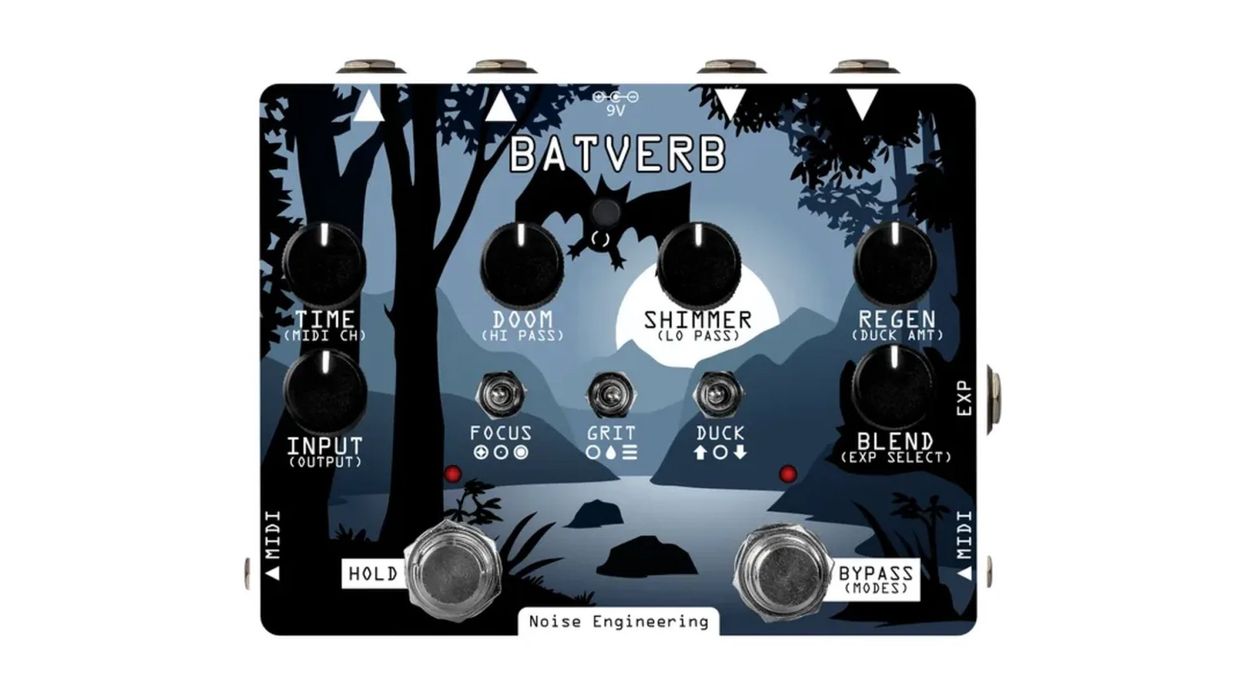
When California-based effects company Noise Engineering released their Desmodus Versio in 2020, it represented the first reverb effect in their product line, but they coined a new term for the DSP-based effect: a synthetic-tail generator. The name reflects the reality that it is, by definition, the Desmodus Versio doesn’t create literal reverberation, as in reflections in a room, but instead builds “tails” onto an audio signal. Taxonomy aside, it was a powerful, well-received, and positively jam-packed digital unit.
The Batverb, launched earlier this year, is an evolution of Noise’s tail-generating efforts. However, it uses brand-new code programmed for Electrosmith’s Daisy Seed DSP platform. A stereo effect box that spans delightful and demented flavors of delay and reverb, the Batverb is generously featured and full of unique takes on space-making effects.
Heads or Tails
The Batverb’s main panel includes six knobs, three 3-way switches, two footswitches, and one “bat” button, which you press and hold to access alternate parameters assigned to the knobs. On the crown are input jacks for either mono or stereo performance as well as MIDI in/out and expression pedal jacks. Up to 16 different presets can be saved and recalled via MIDI.
In normal operation, the knobs govern, from bottom left to bottom right, input volume, time, a suboctave chorus, an octave-up shimmer, “regen” or feedback, and a blend of dry and wet signals. When holding the bat button, those same knobs, in order, control output volume, MIDI channel selection, high-pass filter, low-pass filter, duck amount, and expression pedal parameter assignment. The focus switch changes the diffusion of the delay lines. In the left position it behaves more like a delay, while the other two settings sound and feel more like reverbs. Grit adds, in the middle and right positions, a discrete soft-clipping distortion, and duck determines the responsiveness of the feedback. In the switch’s center position, there’s no ducking. At left, feedback monetarily increases when input volume is received, then tapers off as the signal does. At right, the opposite happens, and feedback increases as the signal gets quieter.
Enter the Bat Cave
To my ears, the Batverb’s more reverb-y patches are in hall or room territory—albeit very cavernous halls or rooms. But reverb sounds created by the Batverb’s algorithms sound more authentic to me than many sought-after reverbs I’ve played. Rather than an indistinct wash of sound, the tails here give the convincing impression of your amp’s signal ricocheting around a high-ceilinged cathedral, at first coming back in clearer, sharper bursts, then melting into smeary ambience. And the handy hold feature can be engaged for infinite regeneration by tapping the footswitch, or for a specific window by pressing and holding. That double utility goes a long way toward determining whether the Batverb sounds organic or unhinged.
The sub- and up-octave content injected by the doom and shimmer knobs is more chaotic and spacious than garden-variety iterations of those effects you’ll find on many octave-based reverbs, and that’s a good thing. Like most effects generated by the Batverb it feels like the product of thoughtful, well-considered programming.
The delay algorithm, engaged with the focus toggle at left, is pleasant and plenty usable, and it’s nice to have alongside the less predictable reverb settings. But the Batverb’s deep tweakability means you can still dial in a broad range of both standard and more marginal delay sounds. The chunky transistor-ish dirt summoned by the grit switch widens the palette further. Add in the touch-sensitive ducking (and its customizable parameters), and you’ve got a ton of ground to play with.
The Verdict
Noise Engineering created an outstanding reverb and tail generator here. Considering its steep asking price, the Batverb will be out of the question for many players, but it’s obviously geared to adventurous players and discerning producers, especially those looking for authentic, parallel universe-conjuring ambience and noise in their studio or live rigs. For these musicians, the Batverb will be more than worth the bite it takes from the bank balance.
Nuno Bettencourt recalls his final conversation with Ozzy Osbourne – as “the only guitar player who said no” to playing for him

Nuno Bettencourt may have been the only guitarist to turn down an offer of playing for Ozzy Osbourne, but the Extreme guitar icon remembers their final conversation together fondly.
Bettencourt was offered a job with the Prince Of Darkness in the 1990s, but turned it down as he was busy with his own band. He’d also previously auditioned to play for Osbourne as a teenager, but didn’t get selected.
In an interview with Page Six on the red carpet at the VMAs, Bettencourt says (via Guitarist), “When I was 15 and his guitar player [Randy Rhoads] passed in a bad plane accident, I believed that I was gonna replace him, and there was an ad to send a cassette in.
“So I did. I put a cassette together at 15, sent it in, [I thought], ‘This is my gig. I’m going to get it.’ Of course, I didn’t,” he continues. “Nobody ever called. Cut to 12 years later, I’m opening for Aerosmith with Extreme in London and my booker comes in and says, ‘Sharon [Osbourne] just called. Ozzy wants you and wants you to be in the band.’ This is like 1995, ’96. I said no.”
Though he admits it’s a regret, Bettencourt caught up with Osbourne at the Back To The Beginning final Black Sabbath gig: “The last words we said to each other when we took the big group photo, I grabbed his hand, saying, ‘Thank you for everything, and thank you, Ozzy, for what you mean to me.’
He goes on to add, “He pulls me in by the hand. He goes, ‘You were the only guitar player who said no to me.’ But he laughed! He goes, ‘I love you and thank you for being here.’”
Bettencourt also joined a supergroup consisting of Yungblud and Aerosmith’s Steven Tyler and Joe Perry at the VMAs to perform a tribute medley in honour of Osbourne. You can watch the performance below:
The post Nuno Bettencourt recalls his final conversation with Ozzy Osbourne – as “the only guitar player who said no” to playing for him appeared first on Guitar.com | All Things Guitar.

